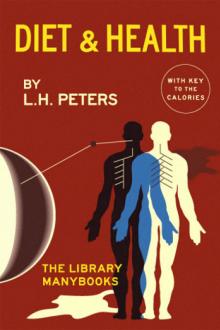Diet and Health by Lulu Hunt Peters (free ebooks romance novels .txt) 📕

- Author: Lulu Hunt Peters
- Performer: -
Book online «Diet and Health by Lulu Hunt Peters (free ebooks romance novels .txt) 📕». Author Lulu Hunt Peters
VEGETABLES
When not otherwise indicated, the method of cooking is by boiling. The caloric value of sauces served with them not included.
FRUITS
BREAD AND CRACKERS
White, gluten, rye, whole wheat, etc., practically same caloric value per same weight. There is so little difference between the caloric value of gluten bread and other breads that it is not necessary for reducing to try to get it. (Toasted bread has the same caloric value that it had before toasting. It is more easily digested, but just as fattening. Advised, however, because it makes you chew.)
BREAKFAST FOODS, ETC.
CANDY, PASTRIES AND SWEETS
Saccharine, a coal tar product 300 to 500 times sweeter than sugar, but of no food value. Not advisable to use habitually. Better learn to like things unsweetened—it can be done.
CONDIMENTS AND SAUCESNUTS
Key to Key
If you will remember the following portions of food, you will have a standard by which to compute your servings:
If food is fried, or butter, oil, or cream sauces are added, the C. value increases markedly.
Review1. Why is a mixture of foods necessary?
2. Give the caloric value of the following: 1 glass of milk, skim; buttermilk; 10 chocolate creams; 1 bag peanuts; 1 pat butter; 1 piece pie.
3. Name foods low in caloric value. Why are they valuable?
4. How many calories of bread and butter do you daily consume?
5. Reckon your usual caloric intake. How much of it is in excess of your needs?
6. Memorize caloric value of foods you are fond of.
This Table of Foods, With the C Given Per Oz. Will Help YouThe caloric value of pure fat is 255 C per oz., dry starches and sugars (carbohydrates), and protein (the meat element), is 113. This means fats are 2-1/4 times more fattening than other foods. Most foods contain considerable water, so the following is an approximate table of foods 'as is.' I have given round numbers in the table so you can more easily remember them. Memorize it.
Calories per oz.
Fats 255 Nuts, edible part 200 Sugar 115 Cream cheese 110 Cottage cheese (no fat) 30 Breads 75 Lean meats 50 Lean fish 35 Eggs (per oz.) 40 Milk, whole 20 Milk, skim and buttermilk (no fat) 10 Milk, condensed, sweet 100 Milk, condensed, unsweet. 50 Cream, thin 60 Cream, thick 110 Fruits: Dried 100 Sweet 25 Acid 15 Vegetables: Potatoes, plain (oz.) 30 Cooked Legumes, (peas, beans, etc.) 20-35 Watery and leafy 5-15
5 Vegetarianism vs. Meat Eating
As protein is the only food which builds and repairs tissue, it is the food which has caused the most controversy.
First: As to the amount needed.
Second: As to whether animal flesh protein is necessary.
AMOUNT NEEDED: It was thought for many years that 150 grams or 5 ounces of dry protein (equivalent to about 1-1/2 pounds lean meat) per day was necessary. But experiments of Chittenden and others have proved that considerably less is sufficient, and that the health is improved if less is taken.
Chittenden's standard is 50 grams, or 1-2/3 ounces, dry protein (equivalent to 1/2 pound meat per day). This is considered by many as insufficient. A variation from 1-2/3 to 3 ounces dry protein per day will give a safe range. (ROSE.)
The amount of protein needed is comparatively independent of the amount of physical exertion, thus differing from the purely fuel foods, carbohydrates and fats, which should vary in direct proportion to the amount of physical exertion. In general, 10 to 15 per cent of the total calories per day should be taken as protein. An excess is undoubtedly irritant to the kidneys, blood vessels, and other organs, and if too little is taken the body tissues will suffer.
Not all of the protein should be taken in the form of animal protein; at least one-half should be taken from the vegetable kingdom.
Animal Flesh Protein
The following are a few of the chief reasons given by those who object to its use:
First: The animal has just as much right to life, liberty, and pursuit of happiness as we have.
Second: They may be diseased, and there is the possibility of their containing animal parasites, such as tapeworms and trichinæ. I would like to tell you more about worms, they are so interesting, but He says not to try to tell all I know in this little book; that maybe he will let me write another sometime, although it is a terrible strain on him, and that I have given enough of the family history, anyway.
Third: The tissues of animals contain excrementitious material, which may cause excess acidity, raise the blood pressure, and so forth.
Fourth: More apt to putrefy and thus give ptomaine poisoning.
Fifth: Makes the disposition more vicious.
(Honest,—animals eating meat exclusively are more vicious.)
Those who believe that animal protein should be eaten answer these points as follows:
First: Survival of the fittest.
Second: If you give decent support to your health departments they can furnish enough inspectors to prevent the marketing of diseased meat; and if some should slip through, if you thoroughly bake, boil, or fry your animal parasites they will lose their pep.
Third: Most of the harmful products are destroyed by the intestines and liver.
Fourth: True, but see that you get good meat, and don't eat it in excess.
Fifth: Unanswerable—to be proved





Comments (0)